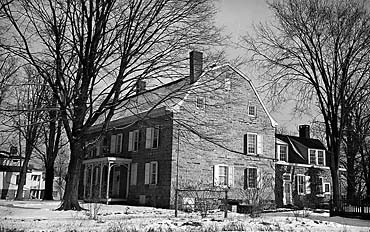Many people do not realize that in the closing years of the American War for Independence, General George Washington journeyed through the scenic Rondout Valley to what we know today as Stone Ridge. Some called it Stoney Ridge during Washington’s time. The General was on his way to Kingston, New York. However, before he arrived at his destination, he dined and slept at the residence of Major Cornelius Evert Wynkoop.
In 1782, the War for American Independence entered its seventh year. Once again, the Hudson River Valley became the focal point for General Washington as he moved his armies ultimately into cantonment in New Windsor. He did not seek quarters in New Windsor, but a short distance away in Newburgh. This Newburgh headquarters became his longest headquarters of the war. The home he lodged in, while in Newburgh, was the house of the late Colonel Jonathan Hasbrouck, located above the chain across the Hudson River at West Point.
Although Washington prepared for his next offensive in the spring, his time at the Hasbrouck house became one of boredom as the war turned into a time of watchful waiting, and eventually slowly progressed towards peace. During this period of time, Washington sometimes toured surrounding areas. He did this in 1782 and again in 1783. The trip we are most interested in is his November 1782 journey.
On November 12, 1782, General Washington penned a letter to then Governor of New York State George Clinton, requesting that he accompany him on a ride to Kingston, then the state capital of New York, which had been burned by the British in October 1777. Washington informed Governor Clinton that he wanted to meet with him on Thursday and together they could ride to Kingston. The Governor declined General Washington’s invitation but Washington set out on his trip anyway, informing General Henry Knox that “he was setting out for Kingston, by way of Poughkeepsy (sic); possibly I may not return before Sunday.”
General Washington, possibly accompanied by his Commander-in-Chief’s Guard, who were his personal bodyguards, eventually made his way from Newburgh up the Kingston Road (which is modern day Route 209). He was heading toward the home of Major Cornelius Evert Wynkoop, a prominent merchant and farmer in Stone Ridge. According to numerous sources, he was a major of the Minute Men in Ulster County as well as a commissioner of the Committee to Detect and Defeat Conspiracies. Major Wynkoop’s home sat almost on what was then called the Kings Highway or the Kingston Road. This is the road which took General Washington to his destination, the Dutch Reformed Church in Kingston.
According to Benjamin Meyers Brink, founder and publisher of Olde Ulster, an early genealogical magazine published in the early 1900s, George Washington arrived at the Wynkoop home in the afternoon of November 15. The major invited the general to spend the night; the general lodged on the second floor. Some sources believe he lodged in a southwest bedroom, while others believe he was in a northwest bedroom.
In Dutch Houses in the Hudson Valley before 1776, Helen Wilkinson Reynolds described the Wynkoop home as being unique in its appearance with a gambrel roof, which most likely made it stand out from the neighbors’ houses. The construction of the house broke with the tradition of building typically seen in the Hudson Valley. The website for this home states that gambrel roofs were not only uniquely American, but quite in fashion during the time when the home was being built in the 1760s. In addition to the above stated unique traits, the Major Wynkoop home was probably the largest in Stone Ridge.
The home we view today on Main Street in Stone Ridge looked much the same to Washington when he arrived in 1782. Even the Black Locust trees, which today line the front of the home, were present when Washington viewed the property. One reason for the numerous Black Locust trees is that some individuals from that time period believed that Black Locusts acted as natural lightening rods and worked to draw lightening away from the house.
The next day on November 16, General Washington departed from the Wynkoop’s home and journeyed up the Kingston Road towards Hurley where he spoke before many excited guests. He continued on into the Town of Kingston where he gave a speech before the people of the town at the Dutch Reformed Church. He eventually returned to Newburgh shortly after his speech in Kingston. He remained in Newburgh until August of 1783.
When residents of the Rondout Valley think about the American War for Independence, they conjure up thoughts of the Hudson River or Saratoga but not usually the Rondout Valley itself. The valley played an appreciable role, especially after the burning of Kingston in 1777. Some examples are: storing state legislature records at the Hardenberg House in Kerhonkson; convening of the legislature for one month at the Oliver House in Hurley; and holding court in Tack’s Tavern in Stone Ridge, across the road from the Wynkoop home where Washington lodged. Although no major battles occurred in our immediate area, there were devastating Indian raids � especially in Wawarsing. Perhaps the most famous raid in our area, known as the Fantinekill Massacre, occurred when Tories and Indians killed members of the Sax and Bevier families outside Ellenville in 1779.
Previously published in the Shawangunk Journal

Leave a comment